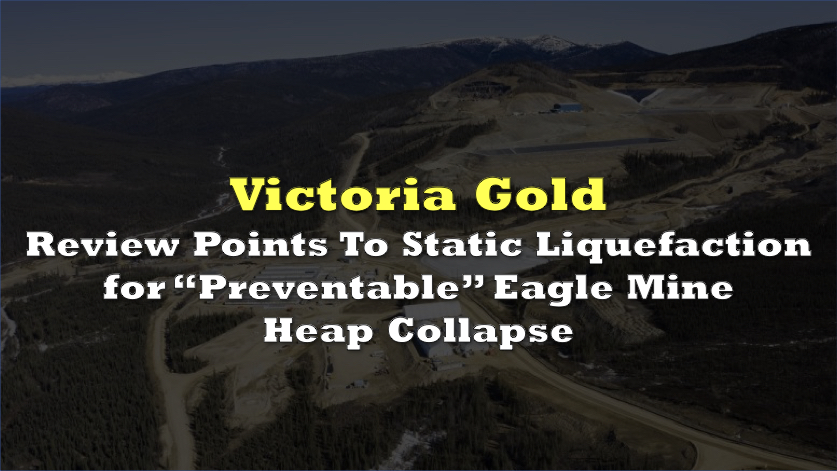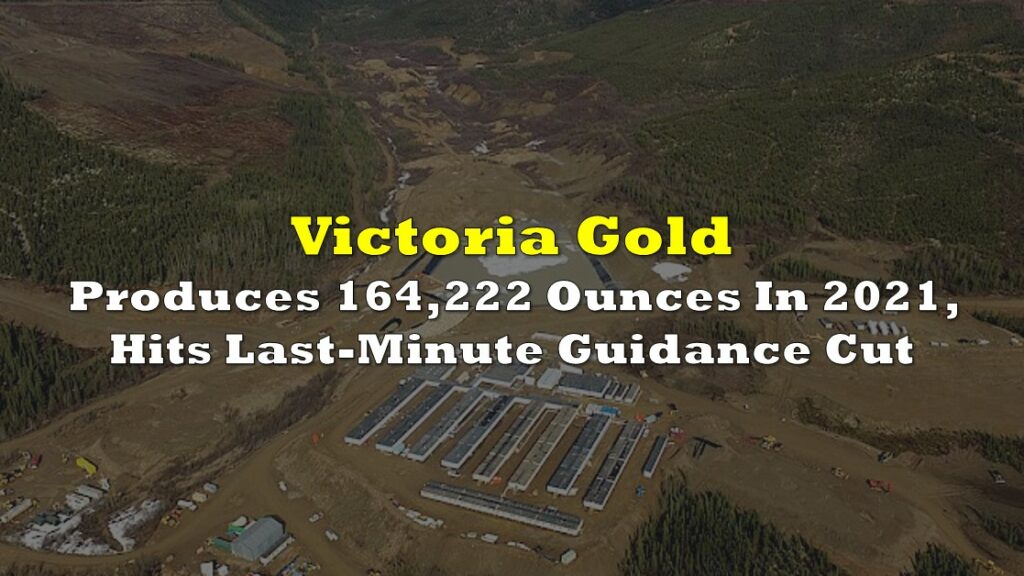An Independent Review Board has delivered the fullest account to date of the June 24, 2024 collapse that sent 1.77 million tonnes of cyanide-laced ore racing out of Victoria Gold’s (TSX: VGCX) Eagle Mine heap-leach pad in Yukon, Canada.
Drawing on thousands of pages of design files, laboratory tests, witness interviews, and coupled thermal–seepage stability models, the 141-page report concludes that “multiple component and cascading failures” converged inside the pad’s south flank, priming it for static liquefaction and a flow slide that ultimately displaced 5.95 million m³ of ore.
Over-steepened slope
The Eagle heap was never meant to stand as steep as it did. Engineer-of-record BGC’s 2019 redesign capped the overall south slope angle at 19.7°, down from the 21.8° in the feasibility layout. Yet to make room for an access ramp between the 960-metre and 1,005-metre elevations, crews truck-dumped ore at an inter-ramp angle of 36.5°—almost double the revised limit—and pushed the overall slope to 22.5°.
Interviews later showed that shift supervisors never got the memo about the gentler target and continued stacking to the steeper geometry embedded in the original drawings, so the deviation persisted lift after lift.
Orthophotos from May 2024 capture the over-steepened face cantilevered above Ann Gulch, with the ramp cut forming a conspicuous 45-metre high “step” in the otherwise planar slope. IRB stress modelling of that cross-section shows shear stresses concentrating along the contact between the steep face and the underlying 975-metre lift, precisely where chronic seepage had been observed since 2021.
The board notes that locally over-steep slopes often spawn small slips, but in this case the geometry abutted the most water-logged, low-strength horizon in the heap, magnifying the hazard.
When the narrow buttress at the toe of the over-steepened zone finally let go, nothing remained to confine the saturated ore behind it. The steep liner beneath the face—graded at 22.5° to 26.5°—had already strained the plastic drain pipes, a deformation the IRB links to impaired out-flow and a rising phreatic surface. Freed of restraint and buoyed by high pore pressures, the weakened lift liquefied and the failure surface propagated upward through the stacked lifts, unleashing the million-tonne flow slide that swept equipment, piping, and cyanide solution.

Low-strength, low-permeability layer
Site stacking logs also show that shear-zone material ultimately made up 76% of the ore placed in the 975-metre lift, trple the blending target of 25–33%. The IRB links this spike to hurried production schedules and the absence of a rigorous ore-tracking system: mine planners routinely parked “problematic” SZM, then lost sight of where it travelled through the three-stage crusher and onto the pad.
By mid-2020, weekly mine plans openly earmarked SZM for the 975-metre bench, even though supervisors warned the material was “soupy” and hard to handle in the pit and on the heap. Within the lift, fines were uneven—some cells carried up to 30% minus-#200 material, others closer to 20%—creating pockets of even weaker ore separated by slightly coarser, marginally better-drained lenses.
Laboratory testing quantifies just how compromised the layer was. Drained friction angles for SZM average 28° with negligible cohesion, versus 36–39° for competent ore, a differential big enough to cut peak shear strength by roughly one quarter. Early feasibility work actually recommended cement agglomeration of low lifts to offset this deficit, but a 2019 cost review dropped that step after a limited test program suggested it was unnecessary. The IRB now calls that decision “pivotal” in allowing a hydraulically tight layer to form.
Hydrologically, the clay-rich horizon behaved like an aquitard: irrigation water perched above it, raising pore pressures not only within the 975-metre lift but also into the overlying 985-metre bench. In short, the misplaced SZM created a low-strength, low-permeability blanket that trapped water, suppressed shear strength, and set the mechanical stage for static liquefaction when external triggers arrived.

Impaired pregnant-leach solution
The review board found that the pregnant-leach solution network delivered only a fraction of its design capacity because the field installation diverged sharply from the drawings. The 100-mm perforated laterals were meant to telescope a full metre inside 250-mm headers. Instead, field crews “butted” them end-to-end, forcing every trickle to exit the small pipe, percolate through the over-liner drain fill, and re-enter the header via its perforations.
Sensitivity checks show that the improvised joint added between 0.5 metre and 5 metre of head loss—far above the 0.6 metre phreatic limit assumed in stability models—effectively mounding the water table wherever laterals met headers. Even when the ODF was unfrozen, that local head built lateral gradients that pushed solution upslope toward the 975-metre bench, mirroring years of chronic seepage mapped on that horizon.
Mechanical damage compounded the hydraulic choke points. Heap settlement of about 0.5 metre per lift distorted the collection grid; aerial photos from 2021 already show 250-mm headers bent off grade and 100-mm pipes lying nearly flat against slopes that exceeded 22.5°. Thermal modelling confirms that large tracts of ODF and ore dropped below 0°C each winter; when frozen zones slid en masse they sheared or buckled the corrugated ABS pipes, reversing the intended downhill slope of some laterals and trapping solution behind high points.
Laboratory work on the same pipe brand revealed that wrapping the perforations with geotextile can slash entrance losses by a factor of fifteen, but no such sleeves were used at Eagle—leaving the network vulnerable to clogging by fine ODF particles.
Hydrologically the heap behaved as if its engineered gravel blanket had been throttled back an order of magnitude. The IRB concludes that a “high probability” of such partial impairment existed well before June 2024; it did not precipitate failure on its own, but it raised pore pressures in precisely the sector already weakened by low-strength shear-zone ore. In effect, the compromised collection network became the unseen hydraulic pump that kept feeding water to the most contractive material in the heap—the final ingredient that allowed static liquefaction to run its course.


Saturation from sprinklers
In April 2024, Victoria Gold restarted bench sprinklers on the 1,005-metre and 1,017-metre lifts even though surface ore and over-liner drain fill were still frozen—a direct departure from the Quartz Mining Licence’s 275-day stacking window and the operation’s own OMS Manual, which bars winter leaching precisely to avoid ice lenses and perched water. Aerial photographs captured within hours of the June 2024 failure show blocky chunks of frozen ore still thawing on the crest, confirming that icy zones persisted deep into the pile as irrigation resumed.
Delve Underground’s forensic review later highlighted frozen ore as a “contributory factor,” noting that chilled layers create hydraulic dams that divert solution laterally and upward toward the active slope face, rather than into the pregnant-solution drains. The IRB found that these early-season flows re-established positive pore pressures more than two months before the slide, essentially pre-loading the heap with water that could not readily escape.
The magnitude of that extra water is quantified in competing audits. Delve’s simplified balance detected 1,000–2,000 m³ day⁻¹ more solution leaving the heap than entering it between summer 2022 and June 2024, an anomaly the firm called a “deficit” but which the IRB reframed as a surplus. Running its own model, the IRB calculated that PLS outflows exceeded barren-plus-make-up inflows by 1,100 m³ day⁻¹; once corrected for precipitation, evaporation, and ore-moisture uptake, the surplus swelled to 2,136 m³ day⁻¹—roughly 780,000 m³ per year. In effect, the heap operated as an unplanned reservoir, absorbing water faster than pump-back and evaporation could remove it.
As the hidden reservoir expanded, numerical seepage–stability models recorded a relentless slide in safety margins. The IRB carried out a counter-factual simulation that suppressed irrigation on the two upper benches; in that scenario the perched water never reached the slope face and FoS stayed well above unity—implying the bench sprinkler restart was the decisive hydraulic trigger.
Once pore pressures intersected the contractive 975-metre shear-zone layer, undrained strengths crashed, liquefaction initiated, and the slope’s last reserve of stability vanished in minutes.

Static liquefaction
Motion sensors buried in the 975-metre bench registered their first anomalous tilt at 05:41 a.m. on June 24, barely 90 seconds before the main failure. Piezometers positioned 15 metres apart in that same lift spiked pressure in under a minute—evidence that a shallow slump had instantaneously transferred undrained load into saturated, contractive ore.
The IRB reconstructed the sequence: a small slab slid off the south face, exposing fresh grey ore, then halted. That brief pause marked the conversion from localized slip to full-scale liquefaction as elevated pore-pressure ratios drove the effective stress in the 975-metre to 1,005-metre lenses toward zero.
Once shear resistance collapsed, the saturated mass behaved as a Bingham fluid. Material-point-method modelling tuned to undrained shear strengths predicted front velocities that match eyewitness accounts that “the slide crossed the haul road in ten seconds.” Run-out simulations show the flow accelerating for the first 330 metres, riding a natural chute in Ann Gulch before fanning out across the Dublin Gulch floodplain. LiDAR differencing measured 1.40 km of horizontal travel and up to 59 m of vertical drop; deposit thickness reached 8.6 metres where the flow banked against the access road. The advancing front bulldozed two 914-mm steel conveyors, snapped the #2 reclaim line, and displaced the in-heap pond pumps downslope, severing power and telemetry.


Not earthquake
The board eliminated alternative triggers by process of exclusion but they did not find evidence of “earthquake, foundation, or dam failure, either as primary or contributing causes.”
Yukon Geological Survey seismographs at Keno Hill and Mayo failed to register any ground motion larger than ML 0.3 within two hours of the event. Finite element back-analysis required no foundation slip to reproduce observed scarp geometry, and the downstream face of the containment dam remained undisturbed, confirming it acted only as a passive barrier.
Triaxial compression tests on shear-zone specimens reproduced contractive behaviour at confining low stresses, reinforcing the conclusion that static liquefaction—water-driven, not earthquake-induced—governed the failure.
The IRB draws parallels to the 2013 Talvivaara nickel heap slide in Finland and the 2015 Bulyanhulu gold pad failure in Tanzania, noting that all three shared a saturated, fines-rich horizon perched above an impaired drain system and all transitioned from creep to catastrophic flow without an external seismic load.

The fallout
The failure unleashed a slurry of roughly 934,000 m³ of cyanide-laden solution and ore beyond containment, infilling 1.4 km of the fish-bearing Dublin Gulch channel and stopping just short of the Lower Dublin South Pond control dam. The IRB characterises the release as “acutely toxic,” noting that both cyanide and dissolved metals were mobilised in the initial wave of debris and pore water.
Within hours, process solution was observed cascading off the fresh scarp face and collecting in surface gullies—visual proof that the heap still contained a large reserve of drainable cyanide liquor. By July 3, Yukon regulators had documented visible sheen and dying aquatic invertebrates in Dublin Gulch.
The environmental threat deepened after the in-heap pond pumping system and liner were destroyed. Deprived of pumps, the pond refilled in a matter of days as dynamic storage—estimated at more than 500,000 m³ of pore water—drained from saturated ore. With no on-site treatment plant capable of stripping cyanide, the overflowing IHP sent fresh solution across the buried dam crest and into the debris field each time precipitation or meltwater raised head inside the heap. The site’s limited emergency storage meant that every unplanned inflow—rain, snowmelt, or irrigation rinse—risked another uncontrolled discharge. Efforts to erect temporary tanks and re-plumb piping have reduced but not eliminated the seepage. As of the IRB’s June 2025 cutoff, contaminated drainage still issued from several vents in the slide mass.
Elevated cyanide concentrations have been detected at the confluence of Haggart Creek and the South McQuesten River, 27 km below the heap, alongside rising levels of ammonia and dissolved metals during spring 2025 freshet sampling. Groundwater monitoring wells closest to the heap show breakthrough fronts, suggesting vertical infiltration through fractured bedrock pathways beneath Dublin Gulch.
In response, the Yukon Department of Energy, Mines and Resources convened an expert hydrology–geochemistry working group, while the Na-Cho Nyäk Dun First Nation formed a task force focusing on fish habitat and food-chain risk.
A full remediation plan—likely to include cyanide destruction, debris removal, and long-term plume containment—remains under development. Until it is funded and executed, the heap continues to bleed process water, and the contamination footprint continues to evolve.

Recommendations
The review board recommends every Class II and III heap-leach facility placed under a standing independent technical review board, active “from design through closure,” so that geotechnical decisions receive expert scrutiny at each life-cycle stage. Owners would have to designate an accountable executive officer—someone senior enough to override production pressures—who is trained to recognise and mitigate geotechnical risk.
All design changes, no matter how minor, must be logged in a searchable records system so that future reviewers can track how the facility diverged from its original intent.
On design itself, the IRB tells owners to treat large heap-leach pads as potential tailings dams in disguise. That means mapping any ore horizons that could liquefy, buttressing them with non-liquefiable rock, and running routine strength-and-permeability tests to confirm that laboratory assumptions still match field reality.
The board also recommeds real-time piezometers and thermistors tied to dashboards that alert operators the moment pore pressures breach trigger values. LiDAR drone surveys, already standard on many tailings dams, should scan heap faces for subtle deformation, and each facility must adopt a trigger-action-response plan that spells out when sprinklers must shut down, when slopes must be evacuated, and when regulators must be notified.
Crucially, licence conditions should empower Yukon inspectors to order pump-downs or stacking halts if TARP thresholds are ignored.
On the regulatory side, the IRB urges Yukon to overhaul its 2023 Mine Waste Management Guidelines so that heap-leach pads fall under the same global standards now applied to tailings dams, and to fold in the forthcoming Large Open Pit heap-leach design guide expected in 2027.
“The failure resulted from a series of events, decisions, and issues during different phases of the project,” the board writes, adding that incidents like Eagle are preventable when governance, design, and monitoring match the health-and-safety culture the mining industry already applies to its most hazardous structures.
Victoria Gold was forced into court-appointed receivership in August 2024 with PricewaterhouseCoopers taking control of the mine and all liabilities. CEO John McConnell expressed his regret over the incident, acknowledging that an “uncontrolled buildup of fluid” may have caused the rock pile to become unstable.
Exploration across Na-Cho Nyäk Dun territory also halted at the First Nation’s request while an impact assessment proceeded, stalling projects by operators such as Hecla Mining and Banyan Gold.
The IRB notes that mine shutdown costs and remediation liabilities now dwarf the $150 million insurance estimate cited during initial court proceedings.
The review came about after the Yukon Government and Na-Cho Nyäk Dun asked for the inquiry in August 2024. Three board members and three technical advisers—spanning heap-leach design, cold-climate geotechnics and environmental chemistry—began work in September. They retrieved core from the still-intact heap, drilled through debris, excavated liner samples, reconstructed water balances, and ran 2-D and 3-D seepage, thermal and limit-equilibrium models.
Information for this story was found via the sources and companies mentioned. The author has no securities or affiliations related to the organizations discussed. Not a recommendation to buy or sell. Always do additional research and consult a professional before purchasing a security. The author holds no licenses.









